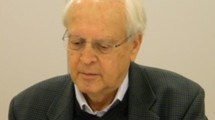Summary
Wound contraction results from the contractile activity of modified fibroblasts, termed myofibroblasts, which are present in the granulation tissue of the healing wound. This study examines the relative role of mechanical tension (stretching) and wound healing as events capable of stimulating the formation of myofibroblasts in mouse skin. The skin of hairless mice was subjected to mechanical stretching and to a small incisional wound either separately or in combination. Animals were killed at intervals between 1 and 6 days and the dermis examined with the electron microscope. Stretching alone produced little evidence of inflammation at any time interval but cells with the ultrastructural characteristics of myofibroblasts were present at 4 days and abundant at 6 days. Skin that had been both stretched and wounded showed a marked inflammatory response and also contained myofibroblasts, but they were less frequent than in the skin subjected to stretching alone. Very few myofibroblasts were evident in skin that had only been wounded. It is suggested that the effect of mechanical tension alone may initiate formation of myofibroblasts in a tissue.
Similar content being viewed by others
References
Azuma M, Enlow DH, Frederickson RG, Gaston LE (1975) A myofibroblastic basis for the physical forces that produce tooth drift and eruption, skeletal displacement at sutures, and periosteal migration. In: McNamara JA, Jr (ed) Determinants of mandibular form and growth. Center for human growth and development, Craniofacial Growth Monograph Series. University of Michigan, Ann Arbor, pp 179–207
Bauer PS, Larson DL, Stacey TR (1975) The observation of myofibroblasts in hypertrophic scars. Surg Gyn Obstet 141:22–26
Becker CG, Hardy AM (1973) Contracted protein in endothelial cells of cerebral arteries and arterioles. Comparison of normotensive and malignant hypertensive states. Circulation 48: Supplement IV, 44
Cottier H, Dreher R, Keller HU, Roos B, Hess MW (1976) Cytokinetic aspects of wound healing. In: Longacre JJ (ed) The ultrastructure of collagen. Charles C Thomas, Springfield, IL, pp 108–131
Croft CB, Tarin D (1970) Ultrastructural studies of wound healing in mouse skin. I. Epithelial behavior. J Anat (Lond) 105:63–77
Fleischer M, Wohlfarth-Bottermann KE (1975) Correlation between tension force generation, fibrillogenesis and ultrastructure of cytoplasmic actomyosin during isometric and isotonic contraction of protoplasmic strands. Cytobiologie 10:339–365
Gabbiani G, Montandon D (1977) Reparative processes in mammalian wound healing: The role of contractile phenomena. Int Rev Cytol 48:187–219
Gabbiani G, Ryan GB, Majno G (1971) Presence of modified fibroblasts in granulation tissue and their possible role in wound contraction. Experientia 27:549–550
Gabbiani G, Herschel BJ, Ryan GB, Stalkov PR, Majno G (1972) Granulation tissue as a contractile organ. A study of structure and function. J Exp Med 135:719–734
Gabbiani G, Majno G, Ryan GR (1973) The fibroblast as a contractile cell: the myofibroblast. In: Kulonen E, Pikkarainen J (eds) Biology of fibroblast. Academic Press, London New York, pp 139–154
Gabbiani G, Badonnel MC, Huttner I, Rona G (1975) Contractile apparatus in aortic endothelium of hypertensive rat. In: Roy PE, Rona G (eds) Recent advances in studies on cardiac structure and metabolism. Vol 10. The metabolism of contraction. University Park Press, Baltimore, pp 591–601
Guber S, Ross R (1978) The myofibroblast. Surg Gyn Obstet 146:641–649
Harris AK, Wild P, Stopak D (1980) Silicone rubber substrata: A new wrinkle in the study of cell locomotion. Science 208:177–179
Hirschel BJ, Gabbiani G, Ryan GB, Majno G (1971) Fibroblasts of granulation tissue: Immunofluorescent staining with anti-smooth muscle serum. Pro Soc Exper Biol Med 138:466–469
Majno G (1979) The story of the myofibroblasts. Am J Surg Path 3:535–542
Montandon D, D'Andiran G, Gabbiani G (1977) The mechanism of wound contraction and epithelialization, clinical and experimental studies. Clinics in Plastic Surgery 4:325–346
Olenhusen KG von, Wohlfarth-Bottermann KE (1979) Evidence for actin transformation during the contraction — relaxation cycle of cytoplasmic actomyosin: cycle blockade by phalloidin injection. Cell Tissue Res 196:455–470
Pitanguy I (1976) Behavior of scar tissue through its evolution with and without surgery with special reference to the chest region in young female patients. In: Longacre JJ, (ed) The ultrastructure of collagen. Charles C Thomas, Springfield IL, pp 316–389
Pohl J, Bruhn HD, Christophers E (1979) Thrombin and fibrin-induced growth of fibroblasts: Role in wound repair and thrombus organization. Klin Wochenschr 52:273–277
Reidy MA, Languie BL (1980) The effect of local blood flow patterns in endothelial cell morphology. Exp. Mol Path 32:276–289
Ryan GB, Cliff WJ, Gabbiani G, Irle C, Montandon D, Statkov PR, Majno G (1974) Myofibroblasts in human granulation tissue. Human Pathol 5:55–67
Singer II (1979) The Fibronexus: A transmembrane association of fibronectin-containing fibers and bundles of 5 nm microfilaments in hamster and human fibroblasts. Cell 16:675–685
Van Winkle W, Hastings JC, Barker E, Wohland W (1973) Role of the fibroblast in controlling rate and extent of repair in wounds of various tissue. In Kulonen E, Pikkarainen J (eds) Biology of fibroblast. Academic Press, New York London, pp 559–570
Author information
Authors and Affiliations
Rights and permissions
About this article
Cite this article
Squier, C.A. The effect of stretching on formation of myofibroblasts in mouse skin. Cell Tissue Res. 220, 325–335 (1981). https://doi.org/10.1007/BF00210512
Accepted:
Issue Date:
DOI: https://doi.org/10.1007/BF00210512



